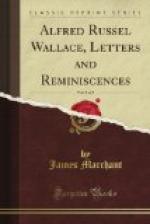In criticising Romanes, however, at the British Association, I want to call your special attention to a point I have hardly made clear enough in my paper. Romanes always speaks of the “physiological variety” as if it were like any other simple variety, and could as easily (he says more easily) be increased. Whereas it is really complex, requiring a remarkable correlation between different sets of individuals which he never recognises. To illustrate what I mean, let me suppose a case. Let there occur in a species three individual physiological varieties—A, B and C—each being infertile with the bulk of the species, but quite fertile with some small part of it. Let A, for example, be fertile with X, Y and Z. Now I maintain it to be in the highest degree improbable that B, a quite distinct individual, with distinct parents originating in a distinct locality, and perhaps with a very different constitution, merely because it also is sterile with the bulk of the species, should be fertile with the very same individuals, X, Y, Z, that A is fertile with. It seems to me to be at least 100 to 1 that it will be fertile with some other quite distinct set of individuals. And so with C, and any other similar variety. I express this by saying that each has its “sexual complements,” and that the complements of the one are almost sure not to be the complements of the other. Hence it follows that A, B, C, though differing in the same character of general infertility with the bulk of the species, will really be three distinct varieties physiologically, and can in no way unite to form a single physiological variety. This enormous difficulty Romanes apparently never sees, but argues as if all individuals that are infertile with the bulk of the species must be or usually are fertile with the same set of individuals or with each other. This I call a monstrous assumption, for which not a particle of evidence exists. Take this in conjunction with my argument from the severity of the struggle for existence and the extreme improbability of the respective “sexual complements” coming together at the right time, and I think Romanes’ ponderous paper is disposed of.
I wrote my paper, however, quite as much to expose the great presumption and ignorance of Romanes in declaring that Natural Selection is not a theory of the origin of species—as it is calculated to do much harm. See, for instance, the way the Duke of Argyll jumped at it like a trout at a fly!—Yours very faithfully,
ALFRED R. WALLACE.
* * * * *
The earlier part of the next letter refers to “The Experimental Proof of the Protective Value of Colour and Markings in Insects in reference to their Vertebrate Enemies,” in the Proceedings of the Zoological Society of London, 1887, p. 191.
TO PROF. POULTON
Frith Hill, Godalming. October 20, 1887.




